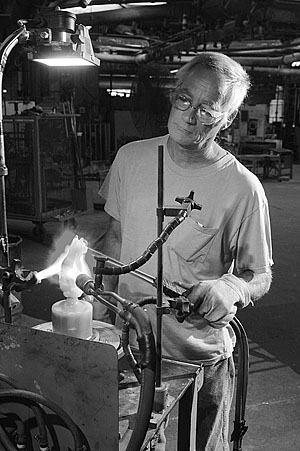
Though operating on a smaller scale since a recent
corporate restructuring, Fenton Art Glass of Williamstown continues
to produce its most popular lines. Here, glassworker Charlie Porter
uses a glazer to fire polish a small cat figurine. Photograph by Michael
Keller.
Fenton
A Century of Art Glass in Williamstown
By Dean Six
Photographs by Michael Keller
In 1905, a small firm began in Martins Ferry, Ohio. They decorated glass made by other companies. The founders, brothers Frank L. and John W. Fenton, soon found that their needs and vision exceeded the available glass and relocated across the river to Williamstown, Wood County. Attractions there included inexpensive land, a dependable supply of natural gas, and ready transportation by train and on the Ohio River. A new factory was begun in 1906, and Fenton Art Glass opened in West Virginia as a maker of handmade glass with their first production on January 2, 1907.
Early offerings included the types of glass that the Fentons had witnessed being manufactured in the firms where they had apprenticed and learned. Opalescent glass, a transparent glass with a milky white rim, was a leader in early Fenton production. Within that first year in West Virginia, Fenton introduced a line of glass in imitation of the more costly art glass from Tiffany, Steuben, and from Europe. The glass had an iridescent finish, which gave the surface the appearance of multicolored oils or rainbows. Today, this type is called carnival glass. Fenton was the original producer of this glass, or one of the first to make it, and it sold in vast quantities.
Over the next few decades, Fenton continued this early trend of being a leader in handmade glass. The company grew to include 142 men and 13 women by 1924. When iridescent carnival and opalescent glass lost favor in the 1920's, Fenton looked to opaque, solid-colored glass. Color names were exotic and included Mandarin Red, Peking Blue, Chinese Yellow, Lilac, Mongolian Green, Periwinkle Blue, and Jade Green. This widely successful glass was made into the early 1930's, until the arrival of the Great Depression. The Depression lead away from these decorative and novelty items toward more practical products. Tableware lines became popular in the 1930's and beyond.
In 1938, Fenton landed an account to make a bottle to be filled and sold with cologne. The bottle had small, sharp points in repeating rows. The design was called hobnail. The hobnail pattern was to become one of the most recognized of all Fenton lines. It continued in production for decades in a multitude of colors and dozens of shapes, with immense numbers of pieces being produced. The 1940's saw the popularity of white “milk glass,” and crested glass — a milk glass (and other colors) with colored or crystal accents along the edges or rims.
In 1948, founder Frank L. Fenton, age 68, died unexpectedly. His brother, Robert C., who had been instrumental in running the company, passed away before the end of the same year. These deaths thrust the management of the Fenton company upon the second generation, specifically Frank M. and Wilmer C. (Bill) Fenton, whose combined leadership would span the next 40 years.
Under this second generation of Fentons, new products continued to be introduced, though the strength and success of the Fenton company rested on utilizing the shapes, forms, and processes of glass that had come before.
You can read the rest of this article in this issue of Goldenseal, available in bookstores, libraries or direct from Goldenseal.